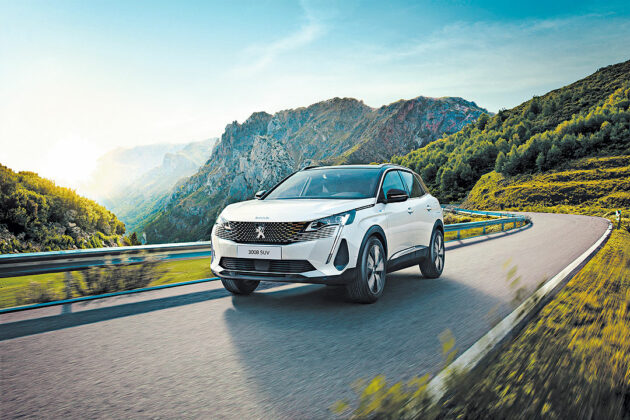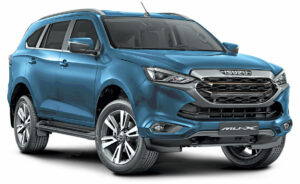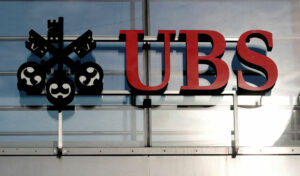The Velocity Q&A: Raoul Picello (Managing Director Peugeot Philippines)

Interview by Kap Maceda Aguila
IN JANUARY, Peugeot Philippines not only launched a new SUV (the 5008) but, more importantly, presented several of the faces behind a new distributor that would take the reins of the French automaker’s operations here.
Astara (formerly known as Bergé Auto) is a huge automotive distribution and mobility services group founded in 1979. Peugeot Philippines said in a release that “the company carved out a successful path as a leading group in distribution and mobility services. Astara is instrumental in the selling of over three million cars as strategic partner of the world’s leading automotive groups.” One of these is Stellantis, the sixth-largest automaker, in charge of no less than 16 brands (including, yes, Peugeot).
Peugeot Philippines (or, more specifically, BA Motors) is now headed by its Managing Director Raoul Picello, who is very bullish about what the company can achieve, but is not averse to admitting that work needs to be done on the brand, its network, and services here.
“Revitalization” is the key theme for the company, and Mr. Picello wants to realize this sooner than later. The executive, who has three decades of experience “across luxury and volume brands” in various capacities, recently took time to speak to us via video chat. Here are excerpts from our one-on-one interview with him.
VELOCITY: You have your work cut out for you, and we’re sure you know that.
RAOUL PICELLO: What do you mean?
From a media standpoint, there was a feeling that Peugeot didn’t take off here like it should have.
I obviously can’t speak for the past. All I know is that in this business, it’s never a matter of one thing. It’s not complicated business, but it’s complex. There are many factors that come into play. Even the greatest product needs other components to connect with the customer, because the customer has a lot of touchpoints with the product. It’s only the ads, the stories you write. He has to experience it; he has to find it near his home. He has to be taken care of when he owns the car, when things need changing. There are a lot of products that are important to a vehicle that are equally important to a great product.
What were your marching orders from Astara when you were assigned to your post here?
What did Astara tell me? Although I have not worked for Astara for many years — I started a year ago — the truth is that I have known them for 20 years. I worked for them in 2000 when they were distributing Toyota and Lexus in Spain. I was hired as sales and marketing director. But then after a year, they gave back the distribution to Toyota Motor company.
But then, obviously, Bergé Auto — which was Astara until two or four months ago — which was the biggest Spanish group, at least top two in my opinion… they told me that part of our strategic plan is grow in Southeast Asia where we see highest potential for growth as a region and Philippines will be the hub of the operations. “Do you want to go and take care of it?”
I was in Hong Kong then and it was funny because it was like going back in time. I lived in Manila for three years when I was a kid. Who could have (predicted) that life would bring me again to the Philippines?
What are your memories of Manila?
I was 11. I can tell you various memories. I remember Ramon Zamora (laughs). I lived in Dasmariñas, went to IS (International, School), of course. I learned to play tennis at Colegio de San Agustin where Maricar (Parco, Peugeot Philippines brand head) went to school. And I would go to Rustan’s to buy the sausage on the stick. I have lots of memories. It was quite a happy period because at that time, Manila was a very safe place. As a kid, I could take a taxi and go to the cinema and go — if I’m not wrong — to Rizal Avenue to watch the cinema. There was a street with lots of cinemas. As a kid of 11 I could go there in a taxi. That was an amazing time!
What did you know about the Philippine auto industry before your Peugeot Philippines assignment?
I didn’t know much, but I would also stress the fact that given the distribution of cars is similar everywhere in the world, problems are the same everywhere in the world. As you said, the brand somehow was left a bit unattended. And when you left things unattended, things would happen as they would anywhere else in the world.
Customers cherish the ownership of a car for the same reasons. You just change the order: Some countries are more practical; others are more emotional. But practicality and emotion are still there among the top three reasons to buy or purchase. And on top, I think once you have the fundamentals in this business, you are in a good place. That’s why we are working honestly to put the fundamentals in place.
But you will not be able to do all these without the product, obviously.
Why the Philippines?
If I tell you that it’s because there was a thorough study of many months, forecasting, macroeconomics, and deciding at the end that the Philippines is the market, I would probably be exaggerating. It’s a series of factors. Some are created by coincidence and by the opportunity, and the others basically the result of the study. Clearly, Astara has access to opportunities considering the partnership Astara has globally with Stellantis (and) other brands.
And all these partnerships are successful. In 30 years of business, Astara has successfully managed many brands and many countries. The reputation with the OEMs is very good. But then to grab the opportunity, you need substance behind it. We have come to the conclusion that the Philippines is the seventh biggest market in Asia, including China and India. There is a great passion and culture for automotive. Honestly, I also think there is space for a mainstream, premium European brand because Philippines is one of those markets where Volkswagen is not so strong, if I may say, without any disrespect. So maybe there is room.
In general, in the Philippines there is room for beautiful cars that are practical at the same time. So size, growth, an economy that’s slowly recovering, a population of 110 million — basically, all these factors converge into the decision.
How does the Stellantis manufacturing facility in Gurun, Malaysia factor into the decision?
You can’t grow in the region if you can’t have local manufacturing — period. But that doesn’t have anything to do with the choice of Philippines, because Gurun is a Stellantis factory, and Astara drives the decisions.
First of all, Peugeot wants to position itself as a mainstream premium brand across the board in all markets. Secondly, if you are perceived to be in the same place as the customers, at the same time it’s the customer who decides the price.
In a way, the price is a given with variations. The fact that there is a factory in Gurun means that we can price and take advantage of different margins because of taxes instead of importing from France or Europe. That’s an important advantage. You cannot succeed in this region if you do not have local manufacturing. Ninety percent of the cars we will sell in 2022 will be sourced from Gurun.
What else can you share about your plans?
When I arrived, we had four outlets of which one was basically a pop-up store owned by EDI (Eurobrands Distributor, Inc., which previously handled the brand here). That was the biggest challenge. Now we are at seven outlets which are either fully operational or very close to being operational, and with visibility to get to 11 or 12, at least by end of the year. I say at least because I still think that we can find a build equation which is interesting for dealers that may be in areas with less industry, less market where I say Peugeot could be difficult to sell with acceptable proposition.
Maybe if we make our standards a bit lighter, we can. I’m talking about a north or east of Pampanga area, for example, where there are brands with outlets in the area (selling) 1,000 cars a year. I am not saying 1,000 is our target because I don’t even care whether it’s 800, 900, 1,000 or 1,200 this year. But maybe we can build something. And if we can build something there, the number could be much higher than 11. I need to be where the customers are and where the customers are enough to make the proposition for the dealer viable.
Then there’s another challenge, but that will take time only because it’s complex and involves processes that both integrate with Stellantis in Singapore and Astara in Madrid. Let’s not forget that BA Motors Philippines started operations formally in December because of COVID. The registration of the company and all licenses arrived only in December, and they should have been there in July. Many contracts could not be signed.
You had said you want the brand back in the Filipino buying menu.
That’s what we want: to be in the radar. Until three months ago, we were not in the radar at all. Part of that is brand awareness. We are spending a lot more in communication — and products. And for that I am confident that we have a proposition for the year, and we are still working toward introducing even more new models. The network is a fundamental pillar of the strategy this year, and then the customer handling processes. That’s also a key area of strategic focus of our business.
We have various opportunities. With the cars we will launch this year, we will be present in a much bigger, larger share of the market. However, to be there with one version is not enough. We need more versions and that’s what we are working toward. Then obviously, if I have to put a wish list together, it’s obviously a pickup. It’s approximately 20% of the market in the Philippines so that would be interesting. And then what we call in Europe as light commercial — that also is important. And that could present opportunities. Stellantis is very strong globally in the commercial vehicles area; probably, it is the strongest group in that segment. And that is also where we’d like to see opportunities.
But again, everything has to come gradually. The network has to grow, products will arrive. There are no overnight miracles.
You’re looking at launching four models this year, according to Maricar.
Including what we’ve launched so far, it’s reasonable to say that this will be the activity of 2022. But I want to bring in more versions also of these models which are equally important. I cannot say anything because we still don’t have certainties.
As far as dealerships are concerned, I would like to have more. It’s the team that has to convince me that I am wrong. Otherwise, I am right.
Astara is known for its robust digital platform. Are you rolling that out here?
The Astara platform has two aspects that are very important. The first one is the platform from the inside — a business management platform that is built on a global scale. (This is for) all the operations that allow us to manage the various aspects of the business. This platform in some aspect is purely internal. The other is mixed, internal-external: To know how many customers walked through the door or showrooms is important. It’s important to know the number and the ask. But it’s also important to know who they are, what’s their name, what they read, where they saw us.
And that’s where we integrate the internal business management platform with the external activity which relies on what the customer wants in terms of mobility. Mobility is changing. It’s no longer wanting a car that I can keep for three, four, five, six years. I have three sons and none of them has a car. None of them cares about owning a car. They share my car.
Car subscription is becoming an important trend which, in my view, will grow in the future. Astara is also growing and rolling out these aspects of the business in all the operations across the world. And it will also come in the Philippines. We will bring it more toward the end of the year, because first we need to put the house in order in terms of internal processes. It will come and it’s going to become one of the key aspects of BA Motors in the Philippines.
Are we going to see an electrified Peugeot vehicle here soon?
I could take an electric Peugeot that’s sold in other markets, import 20 units, distribute them to the dealers… and keep them there until they are ready to be thrown into the bin. But that’s not what we’re meaning to do. We need to build an equation which is viable or close to be viable not only for us but also for the dealer and the customer. For that we need infrastructure, we need support to the owners and the buyers of electric vehicles like everywhere in the market.
When will you see an electrified Peugeot? I don’t know. It could be as soon as two years from now. There is, at the moment, no concrete plan. But that’s because we are not Stellantis. We are a private distributor. We get the information a tad later.
What I can tell you is that the interest in the Philippines from Peugeot management is high. As soon as the opportunities are clear in terms of infrastructure and government incentives (we’ll be ready). What I know also from experience, even those markets who were late in the adoption curve, the ramp-up curve once they adopt is deeper than in the past. The conversation and purchase of electric vehicles for late adopters is steeper than it was in the first market 20 or 15 years ago. I think it’s going to be quicker than what we expect on the one side but is going to be quicker on the adoption than what everybody’s writing.
How do you want Peugeot to be seen as a brand? Do you want to be among the likes of Audi or BMW? Maybe an affordable European marque?
I want to be in the league of — in terms of perception — of Mazda, of Subaru or Honda, although they have different volumes. European that looks great; that’s the area I want to be. Nowhere in the world is Peugeot compared to BMW and Audi — I wish. But it would be very arrogant to think something like that.
I am happy that people think we are expensive. But when they see that we are within reach, it’s a good surprise. Honestly speaking, I prefer this than the opposite.
Honestly, I don’t like the word affordable. Affordable has a lot of connotations — some good, some not so good. What I want is to appeal not to a niche but to a volume — to a lot of people. Then some of them will be able to afford a Peugeot or some others. But if they will buy us, it’s because of the design, because of the practicality, because of the technology and the quality. And when you buy that, you also buy excellent customer service. And that takes time. There is nothing that can be done overnight today in this business, I think.




